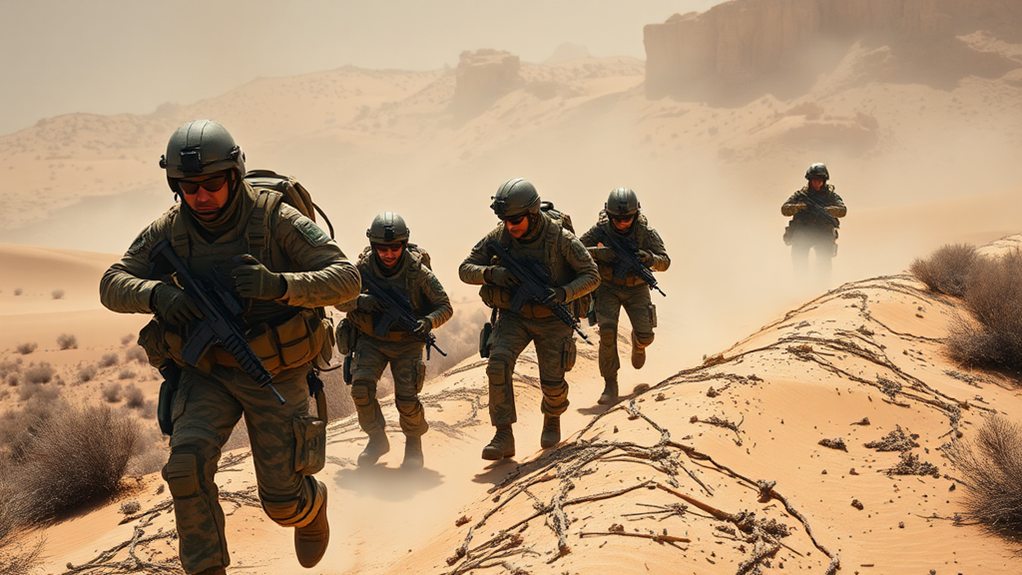Hostile Environment Awareness Training (HEAT)
Hostile Environment Awareness Training (HEAT) equips professionals operating in high-risk global landscapes with critical survival skills and strategic risk management techniques. This specialized training focuses on developing psychological fortitude, situational awareness, and adaptive decision-making capabilities across complex urban and international environments.
Participants learn extensive strategies for threat assessment, crisis communication, and personal safety, tailored to specific professional sectors like media, humanitarian aid, and international development.
HEAT programs utilize scenario-based learning to simulate realistic challenges, transforming potential vulnerabilities into manageable scenarios through proactive preparation and intelligent response mechanisms. Curious minds will find a deeper understanding lies just beyond the surface.
What Makes HEAT Essential
Maneuvering increasingly complex and dangerous global environments demands specialized training that goes beyond traditional safety protocols. HEAT emerges as a critical educational framework for professionals traversing high-risk landscapes, providing thorough skills in risk mitigation and conflict management.
Its core strength lies in preparing individuals to anticipate, assess, and strategically respond to unpredictable threats across diverse terrains.
Modern global challenges require more than reactive approaches; they necessitate proactive, intelligent preparation. HEAT equips participants with a nuanced understanding of environmental dynamics, psychological fortitude, and tactical decision-making.
Critical Skills for Survival
Although survival in hostile environments demands multifaceted competencies, the most essential skills transcend mere physical techniques and encompass a holistic approach to personal security.
Survival psychology plays a pivotal role, in enabling individuals to maintain composure and strategic thinking under extreme stress. Risk mitigation emerges as a vital skill, involving constant situational awareness, threat assessment, and proactive decision-making.
Effective practitioners develop an adaptive mindset that allows rapid response to unpredictable circumstances, transforming potential vulnerabilities into strategic advantages. Mental fortitude, combined with practical skills like basic medical knowledge, communication techniques, and emergency evasion strategies, forms the core of successful survival preparation.
The ability to remain calm, analyze rapidly changing environments, and make calculated decisions ultimately determines one’s capacity to navigate and survive challenging scenarios.
Urban Environments and Challenges
Urban complexity represents a dynamic landscape of multifaceted challenges for professionals operating in high-risk environments. Understanding urban threats demands thorough preparation and adaptive strategies. Maneuvering through these intricate settings requires sophisticated crisis management techniques that transcend traditional survival approaches.
Urban environments present unique risks through them:
- Dense population dynamics
- Complex socio-political infrastructures
- Rapid situational transformations
- Unpredictable human interactions
Successful operatives must develop nuanced awareness, blending seamless observation with strategic responsiveness. Mastering urban terrain involves more than physical manoeuvring it requires psychological fortitude, cultural intelligence, and rapid threat assessment capabilities.
Professionals must continuously interpret subtle environmental cues, anticipate potential escalations, and maintain situational control through calculated, measured responses that prioritize personal safety and mission effectiveness.
Training for Different Professionals
The diverse landscape of Hostile Environment Awareness Training (HEAT) demands specialized approaches tailored to the unique operational requirements of different professional sectors.
- Media professionals, frequently deployed in conflict zones, require intensive training focusing on rapid situational assessment and crisis communication strategies.
- NGO workers encounter distinct challenges, necessitating thorough skills in medical response, cultural navigation, and psychological fortitude when operating in volatile humanitarian environments.
- Specialized HEAT programs address sector-specific risks, integrating scenario-based learning that simulates realistic threat landscapes.
- Journalists learn advanced evasion techniques, while humanitarian workers develop nuanced negotiation skills critical for maintaining personal safety and mission effectiveness.
- These targeted training modules guarantee professionals can confidently navigate high-risk settings, transforming potential vulnerabilities into strategic advantages through strategic preparedness.
Developing Personal Safety Strategies
Cultivating robust personal safety strategies forms the cornerstone of effective Hostile Environment Awareness Training (HEAT), enabling individuals to proactively mitigate risks in unpredictable and potentially dangerous settings.
Strategic preparation involves thorough risk assessment techniques that transform potential vulnerabilities into manageable scenarios. Key elements of personal safety development include:
- Mastering situational awareness
- Implementing self-defence techniques
- Developing rapid threat evaluation skills
- Creating adaptive response protocols
Professional HEAT training emphasizes dynamic learning, teaching participants to read environmental cues, understand potential confrontation indicators, and maintain calm under pressure.
Final Thoughts
Hostile Environment Awareness Training (HEAT) stands as a critical preparatory framework for professionals manoeuvring high-risk global environments. By systematically developing adaptive skills, thorough safety protocols, and strategic response capabilities, HEAT transforms potential vulnerability into operational fortitude.
The training transcends traditional risk management, offering nuanced techniques that empower individuals to anticipate, assess, and effectively mitigate complex security challenges across diverse professional landscapes.
What Makes HEAT Essential
HEAT represents a sophisticated approach to professional survival in volatile regions. Traditional safety training often falls short when confronting unpredictable, dynamic threats. This specialized methodology bridges critical knowledge gaps, equipping professionals with targeted skills for manoeuvring complex security environments.
The core philosophy centres on proactive preparation. Rather than reactive responses, HEAT emphasizes anticipatory awareness, strategic decision-making, and psychological preparedness. Understanding potential risks before encountering them becomes the foundational strategy for maintaining personal and operational safety.
Critical Skills for Survival
Effective HEAT training encompasses multiple critical competencies:
- Risk Assessment Techniques
- Rapid environmental scanning
- Threat identification protocols
- Pattern recognition strategies
- Medical Emergency Preparedness
- Basic trauma management
- Field first aid techniques
- Emergency medical intervention skills
- Communication and Negotiation
- Cross-cultural communication strategies
- Conflict de-escalation methods
- Psychological fortitude techniques
Urban Environments and Challenges
Urban settings present unique security complexities. Densely populated areas amplify potential risks, requiring nuanced manoeuvring skills. HEAT training addresses urban-specific challenges like:
- Crowd management
- Movement through restricted zones
- Quick route adaptation
- Situational awareness in complex landscapes
Training for Different Professionals
HEAT’s adaptability makes it valuable across diverse professional domains:
- Humanitarian Workers: Maneuvering conflict zones
- Journalists: Reporting from high-risk regions
- Corporate Executives: International travel safety
- Government Agents: Operational security protocols
Developing Personal Safety Strategies
Personal safety emerges from a combination of knowledge, psychological preparation, and practical skills. HEAT emphasizes:
- Mental fortitude
- Situational adaptability
- Continuous learning
- Advanced risk mitigation techniques
Hostile Environment Awareness Training represents a transformative approach to professional safety. By integrating sophisticated skill sets, psychological preparedness, and strategic awareness, HEAT empowers individuals to manoeuvre complex global environments.
The training transcends traditional safety protocols, offering thorough, adaptable strategies that fundamentally reframe risk management in high-stakes professional contexts.







